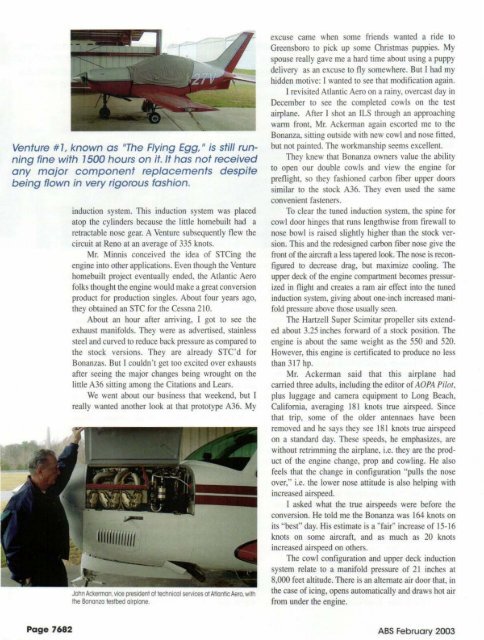February 2003 - American Bonanza Society
February 2003 - American Bonanza Society
February 2003 - American Bonanza Society
You also want an ePaper? Increase the reach of your titles
YUMPU automatically turns print PDFs into web optimized ePapers that Google loves.
Venture #1, known as "The Flying Egg." is still running<br />
fine with 7 500 hours on it. It has not received<br />
any major component replacements despite<br />
being flown in very rigorous fashion.<br />
induction system. This induction system was placed<br />
atop the cylinders because the little homebuilt had a<br />
retractable nose gear. A Venture subsequently flew the<br />
circuit at Reno at an average of 335 knots.<br />
Mr. Minnis conceived the idea of STCing the<br />
engine into other applications. Even though the Venture<br />
homebuilt project eventually ended, the Atlantic Aero<br />
folks thought the engine would make a great conversion<br />
product for production singles. About four years ago,<br />
they obtained an STC for the Cessna 210.<br />
About an hour after arriving, I got to see the<br />
exhaust manifolds. They were as advertised, stainless<br />
steel and curved to reduce back pressure as compared to<br />
the stock versions. They are already STC'd for<br />
<strong>Bonanza</strong>s. But I couldn't get too excited over exhausts<br />
after seeing the major changes being wrought on the<br />
little A36 sitting among the Citations and Lears.<br />
We went about our business that weekend, but I<br />
really wanted another look at that prototype A36. My<br />
John Ackerman. vice president of technical services of Allantic Aero, with<br />
the BonanzQ testbed airplane.<br />
excuse came when some friends wanted a ride to<br />
Greensboro to pick up some Christmas puppies. My<br />
spouse really gave me a hard time about using a puppy<br />
delivery as an excuse to fly somewhere. But I had my<br />
hidden motive: I wanted to see that modification again.<br />
I revisited Atlantic Aero on a rainy, overcast day in<br />
December to see the completed cowls on the test<br />
airplane. After I shot an lLS through an approaching<br />
warm front, Mr. Ackerman again escorted me to the<br />
<strong>Bonanza</strong>, sitting outside with new cowl and nose fitted,<br />
but not painted. The workmanship seems excellent.<br />
They knew that <strong>Bonanza</strong> owners value the ability<br />
to open our double cowls and view the engine for<br />
preflight, so they fashioned carbon fiber upper doors<br />
similar to the stock A36. They even used the same<br />
convenient fasteners.<br />
To clear the tuned induction system, the spine for<br />
cowl door hinges that runs lengthwise from firewall to<br />
nose bowl is raised slightly higher than the stock version.<br />
This and the redesigned carbon fiber nose give the<br />
front of the aircraft a less tapered look. The nose is reconfigured<br />
to decrease drag, but maximize cooling. The<br />
upper deck of the engine compartment becomes pressurized<br />
in flight and creates a ram air effect into the tuned<br />
induction system, giving about one-inch increased manifold<br />
pressure above those usually seen.<br />
The Hartzell Super Scimitar propeller sits extended<br />
about 3.25 inches forward of a stock position. The<br />
engine is about the same weight as the 550 and 520.<br />
However, this engine is certificated to produce no less<br />
than 317 hp.<br />
Mr. Ackerman said that this airplane had<br />
carried three adults, including the editor of AOPA Pifo/,<br />
plus luggage and camera equipment to Long Beach,<br />
California. averaging 181 knots true airspeed. Since<br />
that trip, some of the older antennaes have been<br />
removed and he says they see 181 knots true airspeed<br />
on a standard day. These speeds, he emphasizes, are<br />
without retrimming the airplane, i.e. they are the product<br />
of the engine change, prop and cowling. He also<br />
feels that the change in configuration "pulls the nose<br />
over," i.e. the lower nose attitude is also helping with<br />
increased airspeed.<br />
I asked what the true airspeeds were before the<br />
conversion. He told me the <strong>Bonanza</strong> was 164 knots on<br />
its "best" day. His estimate is a "fair" increase of 15-16<br />
knots on some aircraft, and as much as 20 knots<br />
increased airspeed on others.<br />
The cowl configuration and upper deck induction<br />
system relate to a manifold pressure of 21 inches at<br />
8,000 feet altitude. There is an alternate air door that, in<br />
the case of icing, opens automatically and draws hot air<br />
from under the engine.<br />
Page 7682<br />
ABS <strong>February</strong> <strong>2003</strong>

















